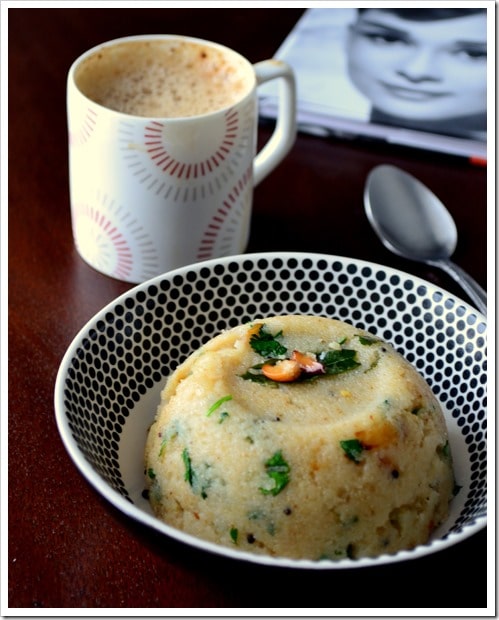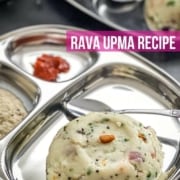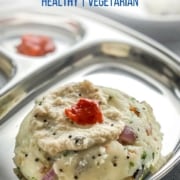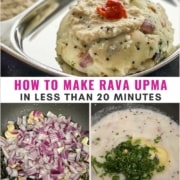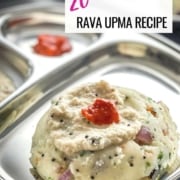In case you are on the lookout for a South Indian rava upma recipe that’s soft, moist and melts in your mouth, identical to those served in Udupi restaurants, then you definately are at the appropriate place.
Ready in 20 minutes, this delicious semolina-based breakfast dish makes for a filling and satisfying meal when paired with coconut chutney and sambar.
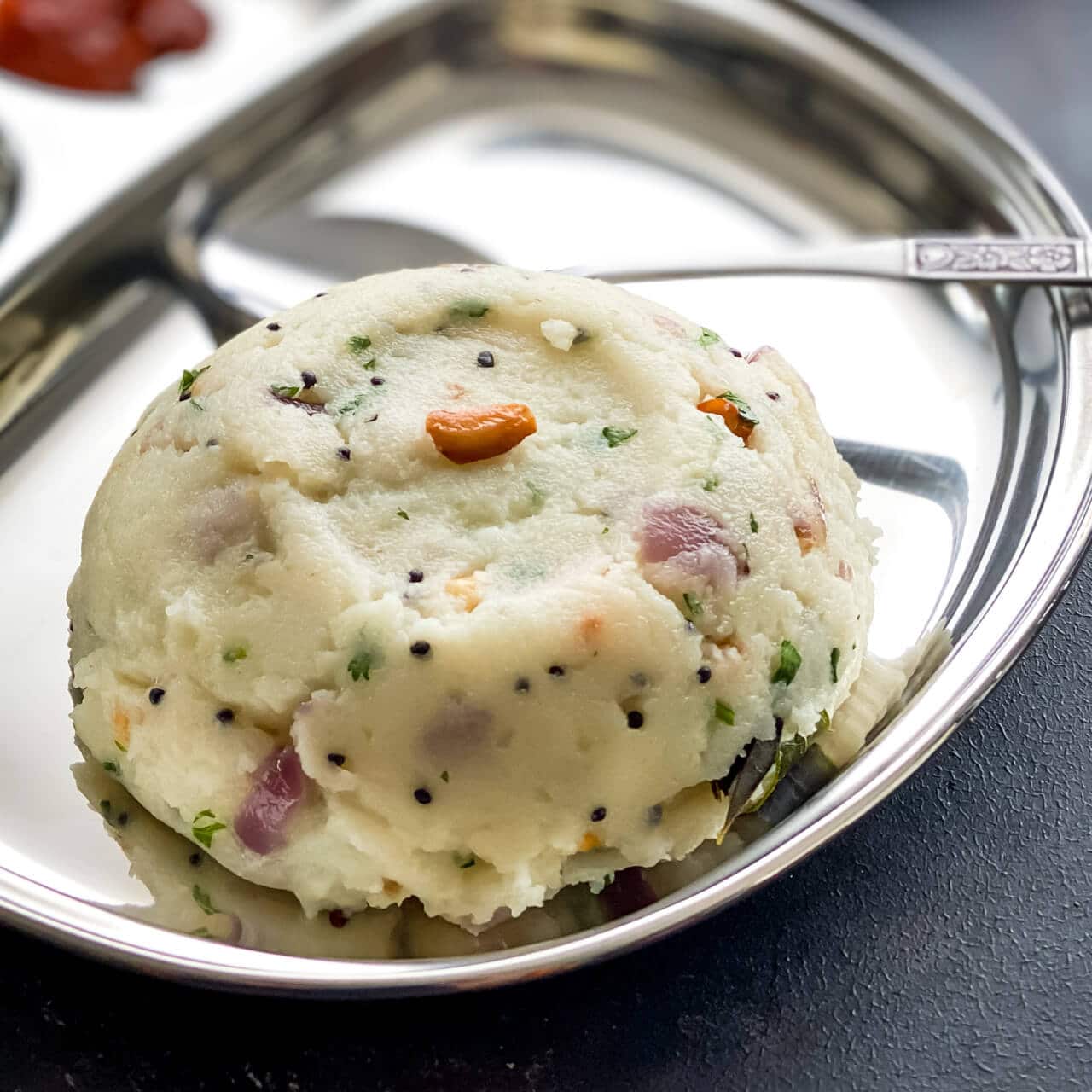
What’s upma
Upma is a preferred South Indian breakfast/snack dish made out of semolina or cream of wheat. Semolina known as rava in most South Indian homes, whereas in Northern India, it’s popularly called sooji or suji.
For individuals who never had rava upma, consider it as a savory porridge made out of semolina as its key ingredient. It’s made by roasting semolina till it turns fragrant, which is then cooked in boiling water. The flavour on this dish comes from the addition of sauteed onions, green chilies, and the tempering of mustard seeds, urad dal, chana dal, and curry leaves.
While upma is commonly served as breakfast or snack in South India and Maharashtra, you may pack it for school/office lunch too. It makes for a filling meal when loaded with veggies.
The undeniable fact that it is simple to cook and takes little or no time can be one in every of the the reason why it’s a preferred item to serve in hostels and enormous gatherings.
History of the recipe
Though the origin of this scrumptious dish is shrouded in mystery, it might be a modified version of asimple meal that widows used to eat in the times of yore. The widows weren’t presupposed to have salt or spices, so that they used to eat rava cooked in water for dinner.
Over the centuries, it probably evolved right into a quick and delicious snack between meals and into the upma that we all know.
is thought by many alternative names across the country. It known as Kharabhat and Uppittu in Kannada, Uppumavu in Tamil, Uppindi in Telugu, and in Marathi, it known as Uppeet, but probably the most commonly used name is upma, rava upma, suji ka upma.
It’s believed the name is derived from the word uppu – which in lots of South Indian languages is the word for salt and mavu, which is the word for flour.
What’s rava / semolina?
Semolina (rava / rawa) is the coarse flour made out of the endosperm of durum wheat – a selected number of wheat. While the remainder of the world uses semolina flour in pasta, porridge, and bread, Indians find it irresistible to make savory and sweet dishes equivalent to –
- Rava laddoo – sweet, crumbly balls made out of semolina which can be a hot favorite with folks of all ages!
- Suji ka halwa – Crumbly, sweet, and delicious – that’s how you’d describe sheera, also often known as suji ka halwa. Learn how one can make this straightforward and traditional dessert in lower than half-hour.
- Rava idli – Enjoy hot, soft, and fluffy idlis anytime with this easy quick rava idli recipe.
How is semolina different from whole wheat flour?
I do know semolina sounds very much like whole wheat flour, nevertheless it will not be. To grasp the difference between the 2, you could understand the various parts of the wheat kernel.
A wheat kernel has three edible parts – bran(outer skin wealthy in fiber and antioxidants), endosperm (the biggest a part of the kernel that incorporates starchy carbs and proteins), and germ (the embryo which incorporates healthy fats, proteins, vitamins, and minerals).
The difference between whole wheat flour (atta in Hindi) and semolina is that atta is made out of the whole wheat kernel (including the bran, germ, and endosperm), while rava is made only from the endosperm.
Since fiber, vitamins, and minerals are lost in the course of the processing of durum wheat to make semolina, manufacturers often add nutrients to create an enriched semolina product that has a better fiber and protein content.
Is semolina (rava) healthy?
Here’s why enriched semolina is nice for you –
- Supports heart health – Semolina incorporates nutrients like folate and magnesium which can be considered heart-healthy.
- Boosts energy – Enriched semolina is wealthy in micro-nutrients, minerals, and vitamins like thiamine and folate that help energy production.
- Keeps you from snacking – Being wealthy in protein, semolina takes longer to digest and keeps you satiated for a very long time avoiding unnecessary snacking.
Here is an informative article to spruce up your knowledge on semolina – its dietary value and health advantages.
What type of rava to make use of in upma?
Upma is usually made out of Bombay rava (the coarser type of rava), but you may as well use Bansi rava (nice semolina).
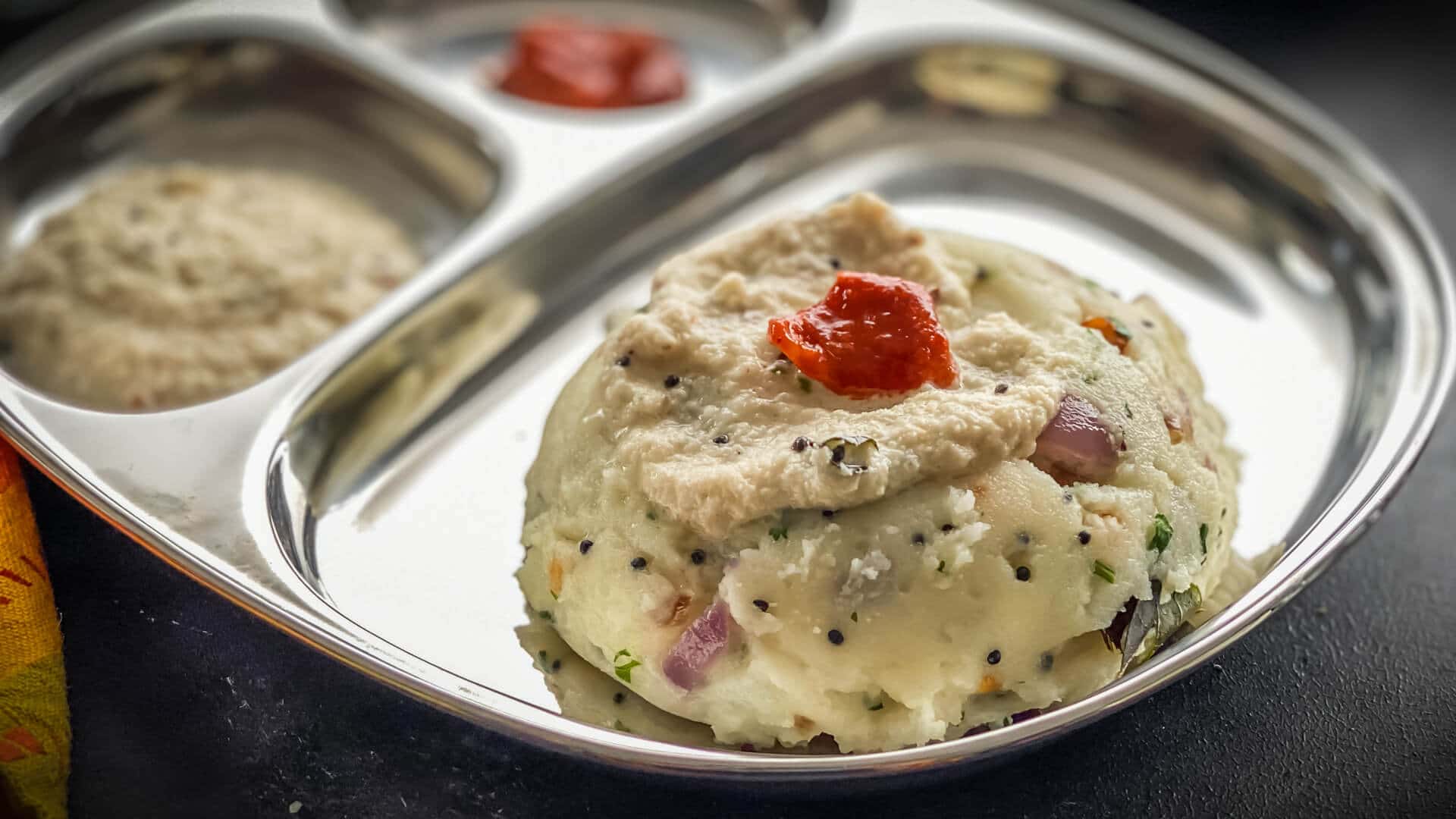
Here’s what you could make the recipe
Methods to make upma
There are two ways to make upma – a technique is to make it moist, and the opposite version is dry, fluffy, and crumbly, very very similar to the suji halwa (sweet semolina pudding). My mom used to make the drier version which I used to be not an enormous fan of (sorry, Mom!).
My dislike for upma continued into maturity until I got here across this soft and moist version in a Udupi restaurant. The upma they served was very moist (those melt-in-the-mouth kinds) and was accompanied by coconut chutney and sambar.
I wondered what was different from the opposite versions I actually have had before, and I spotted it got here all the way down to three things – the mixed in while cooking.
Step-by-step instructions to make rava upma
- In a saucepan, add 3 cups of water and let it come to a boil.
- Meanwhile, heat oil (or ghee if using) in a medium-sized wok kept over medium heat, after which add mustard seeds.
- As they start to crackle, add curry leaves, urad dal, and cashews(if using). Fry them for a minute.
- Add grated ginger, chopped chilies, and onions. Fry the onion till they’re translucent. Add salt and sugar. Mix well.
- Reduce the warmth to medium-low. Add sooji and proceed frying till it starts to vary to a light-weight golden brown color and a sweet aroma emanates from the mixture (roughly 6-8 minutes).
- Add hot water rigorously to the semolina mixture and keep stirring the upma as you add water to make sure it’s lump-free.
- Lower the gas to a simmer. Cover and cook for two minutes until all of the water is absorbed and the sooji mixture is moist but not dry.
- Add ghee and cilantro and blend them in.
- Take the wok off the warmth and serve upma hot as is or accompanied by chutney, pickle, or sambar.
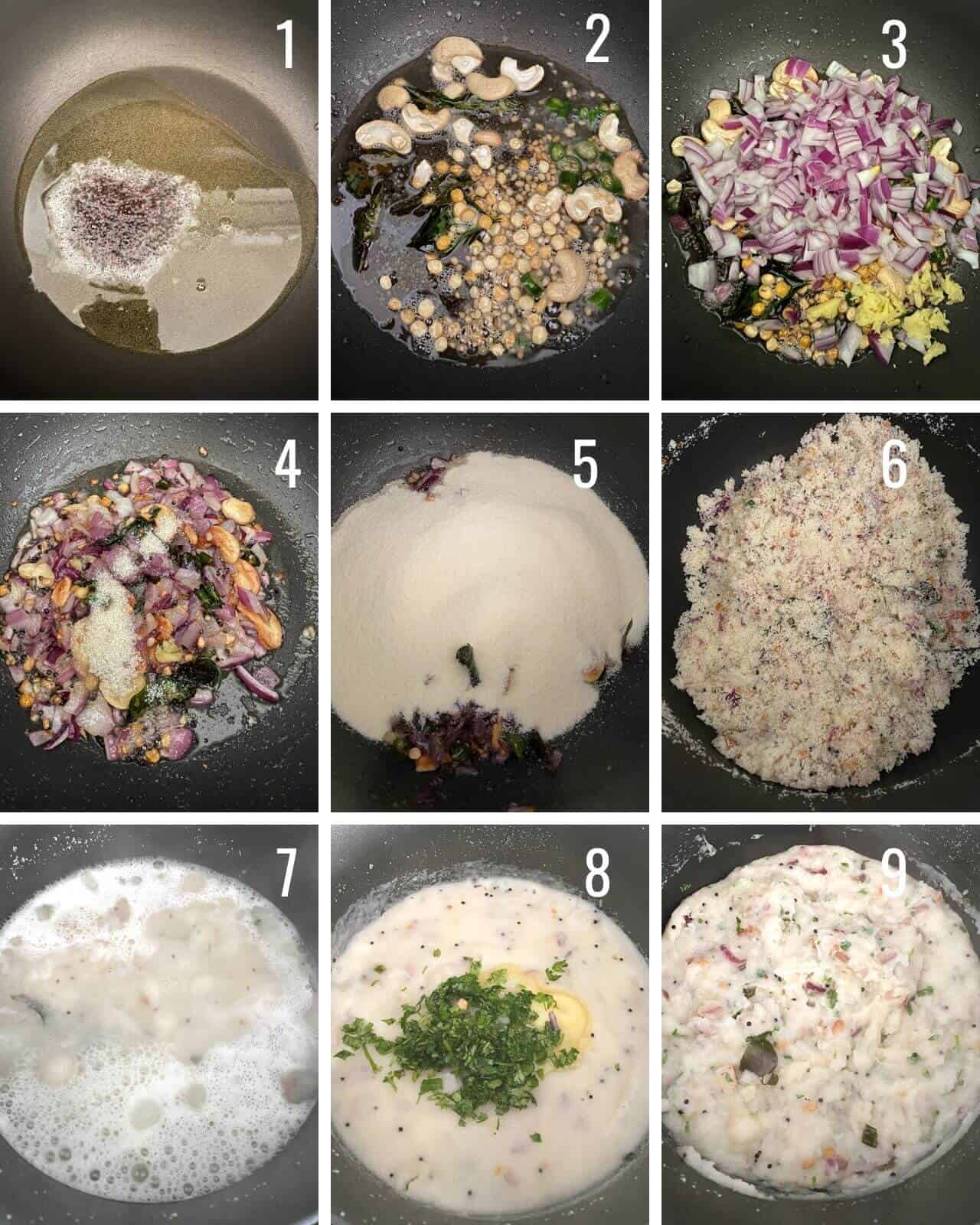
Traditional sooji upma recipe
Note: Traditionally, the means of making upma is barely different (see below). I like my process listed above higher since it is quicker and tastes just nearly as good 🙂
- Dry roast the semolina in medium-low heat in a wok till it turns fragrant (6-8 minutes). Transfer the semolina to a plate.
- Then to the identical wok, add oil or ghee. Set the warmth to medium. Once the oil/ghee has been heated, add mustard seeds.
- As they start to crackle, add curry leaves, urad dal, chana dal, and cashews(if using). Fry them for a minute.
- Add grated ginger, chopped chilies, and onions. Fry the onions till they’re translucent. Add salt and sugar. Mix well.
- Add water to the onions. Let the water come to a boil, after which add the roasted semolina, a number of tablespoons at a time. Stir constantly to avoid lumps.
- Lower the gas to a simmer. Cover and cook for two minutes until all of the water is absorbed and the sooji mixture is moist but not dry.
- Add ghee and cilantro and blend them in.
- Take the wok off the warmth and serve upma hot as is or accompanied by chutney, pickle, or sambar.
Tricks to avoid lumpy/sticky upma
Variations to try
- Vegetable rava upma – It’s also possible to add veggies equivalent to tomatoes, green peas, and chopped carrots to this dish. After the onions turn soft, add about 1/4 cup each of finely chopped tomatoes, peas, and carrots. Saute them till they’re cooked through. Add the rava and follow the remainder of the steps within the recipe card below.
- You would top this dish once cooked with some freshly grated coconut to combine it up.
- To make it vegan, replace ghee with coconut oil.
- Finish off with lime juice – once the cooking is accomplished, add a couple of tablespoon of freshly squeezed lime juice together with cilantro for added flavor.
Methods to prep ahead
A method is to make the quick rava upma mix, as shared below. The opposite way is to merely roast the rava prematurely. Let the roasted rava cool and store it in an airtight container for as much as 6 months. Don’t have to roast the rava again once you make upma – this could shave 6-8 minutes out of your total cooking time.
Quick Rava Upma Mix
Have you ever heard of the Quick upma mix? It’s identical to quick oatmeal, where you could add hot water to the combo, and it’s able to eat. The combination lasts for about per week, unrefrigerated, and for a couple of month within the fridge, making it ideal for traveling or for once you need a quick breakfast or snack.
Here’s how one can make the Quick rava upma mix –
- Skip the onions – using them decreases the shelf lifetime of this mix.
- Meanwhile, heat oil (or ghee if using) in a medium-sized wok kept over medium heat, after which add mustard seeds.
- As they start to crackle, add curry leaves, urad dal, chana dal, and cashews(if using). Fry them for a minute till the curry leaves are crisp.
- Add grated ginger and chopped chilies. Add salt and sugar. Mix well.
- Add sooji and proceed frying till it turns light brown and a sweet aroma emanates from the mixture (roughly 6-8 minutes).
- Once the semolina is roasted, turn off the warmth.
- Allow the mixture to chill down completely before storing it in either glass containers or Ziploc bags.
- Add hot water to the combo for a fast breakfast, stir, and luxuriate in. For each cup of premade mix, use 3 cups of hot water.
Storage suggestions
Refrigerator: Store any leftover rava upma in an air-tight container within the refrigerator for as much as 2-3 days.
Freezer: Cool the upma completely before freezing it in a freezer-safe container. Before reheating, thaw overnight within the refrigerator for best results.
Reheat: To reheat, sprinkle a number of drops of water (if the upma looks very dry) and blend well. Microwave it for 30-60 seconds until heated through.
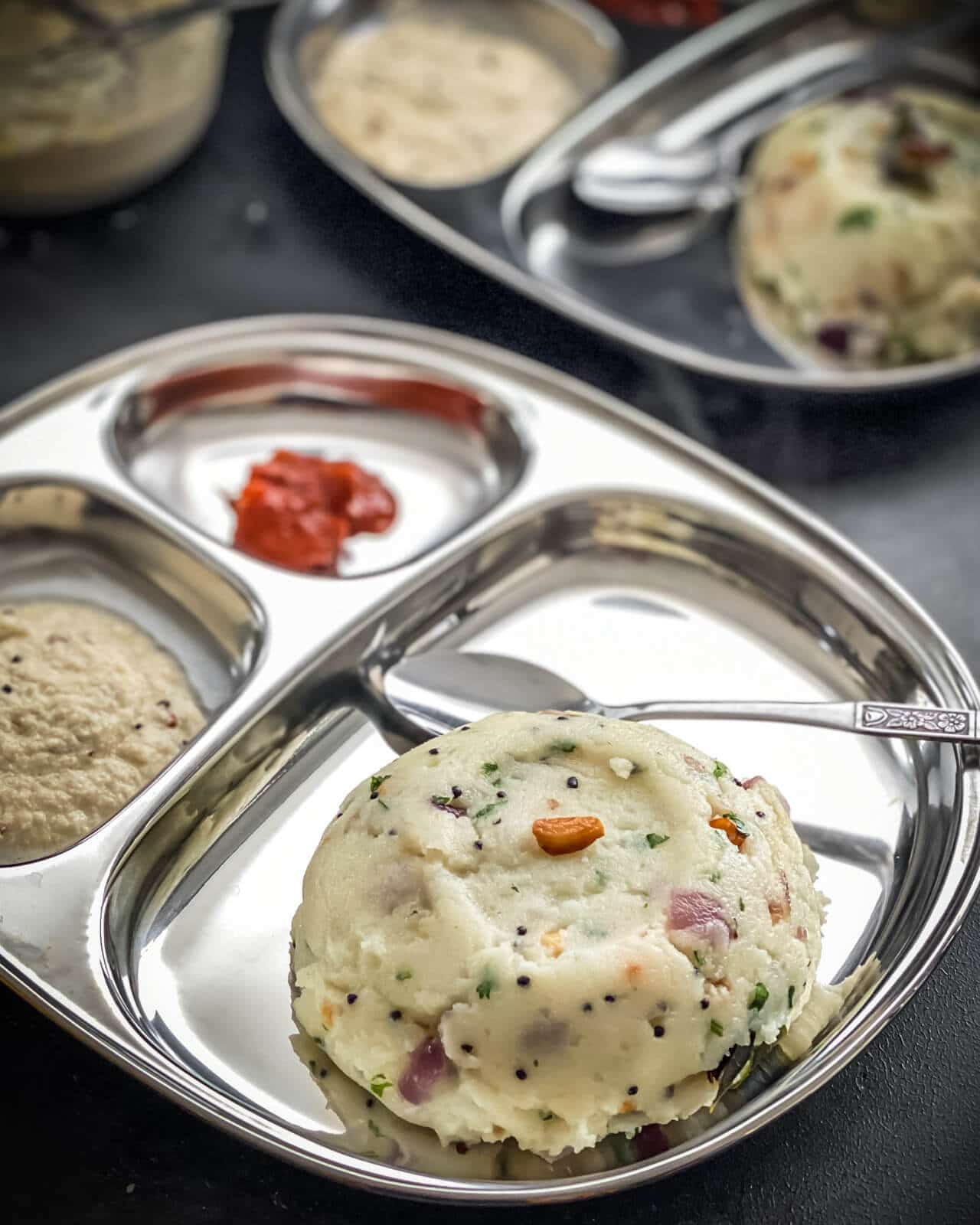
Other easy breakfast recipes to try
Hope you liked this upma recipe, and should you are on the lookout for easy and delicious breakfast recipes, listed below are my reader favorites –
- Semiya Upma (Lemon Vermicelli) – This delicious and tangy South Indian breakfast dish is just what you could start your day. It’s filling and comes together in quarter-hour from start to complete.
- Idli – You’ll love this post should you struggle to get soft and spongy idlis. Learn all my suggestions and tricks to get perfect fermented batter even in winter!
- Buttermilk dosa – Delicious and soft, this dosa is ideal for breakfast, snacks, and even lunch. Learn how one can make it in a number of easy steps.
- Bread upma – Savory, filling, and quick to make, this south Indian style bread upma recipe comes together in 20 minutes for a comfy and satisfying breakfast.
- Non-Sticky Sabudana Khichdi – This step-by-step recipe will show you how one can make sabudana khichdi that appears as great because it tastes. No more clumpy or sticky mess!
This recipe rocks because..
You’ll get the identical taste and texture of restaurant-style rava upma but with fewer steps!
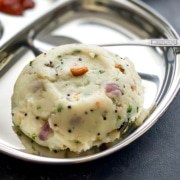
Restaurant-Style Rava / Sooji Upma Recipe
In case you are on the lookout for a South Indian rava upma recipe then you definately are at the appropriate place. This recipe will yield you a soft, melt-in-your-mouth upma in lower than 20 minutes.
- 3 cups water
- 2 tablespoons ghee or oil
- ½ teaspoon mustard seeds
- 1 sprig of curry leaves or kadipatta kadipatta roughly 10-12 leaves
- 1 teaspoon urad dal
- 1 teaspoon chana dal
- 1 teaspoon cashew nuts chopped finely
- 2 Indian or Thai green chilies (Bird’s eye) slit lengthwise
- ½ cup chopped onions
- 1 teaspoon grated ginger
- 1 teaspoon sugar
- 1.5 teaspoons salt or to taste
- 1 cup sooji / rava semolina / Bombay rava
- 1 tablespoon ghee optional
- 1 tablespoon finely chopped cilantro / coriander leaves for garnishing
Prevent your screen from going dark
- Follow the 1:3 ratio, i.e. for each cup of semolina, use 3 cups of water. In case you prefer it more crumbly and dry, use 2.5 cups of water as an alternative of three.
- When the rava is finished cooking, add a tablespoon of ghee and chopped cilantro. Mix them well and take the upma off the warmth immediately.
Note: Traditionally, the means of making upma is barely different, as noted below. I like my process listed above higher since it is quicker and tastes just nearly as good 🙂
- Dry roast the semolina in medium-low heat in a wok till it turns fragrant (6-8 minutes). Transfer the semolina to a plate.
- Then to the identical wok, add oil or ghee. Set the warmth to medium. Once the oil/ghee has been heated, add mustard seeds.
- As they start to crackle, add curry leaves, urad dal, chana dal, and cashews(if using). Fry them for a minute.
- Add grated ginger, chopped chilies, and onions. Fry the onions till they’re translucent. Add salt and sugar. Mix well.
- Add water to the onions. Let the water come to a boil, after which add the roasted semolina, a number of tablespoons at a time. Stir constantly to avoid lumps.
- Lower the gas to a simmer. Cover and cook for two minutes until all of the water is absorbed and the sooji mixture is moist but not dry.
- Add ghee and cilantro and blend them in.
- Take the wok off the warmth and serve upma hot as is or accompanied by chutney, pickle, or sambar.
Variations
- It’s also possible to add veggies equivalent to tomatoes, peas, and carrots to this dish. After the onions turn soft, add about 1/4 cup each of finely chopped tomatoes, peas, and finely chopped carrots. Saute them till they’re cooked through.
- You would top this dish once cooked with some freshly grated coconut to combine it up.
- To make it vegan, replace ghee with coconut oil.
- Finish off with lime juice – once the cooking is accomplished, add a couple of tablespoon of freshly squeezed lime juice together with cilantro for added flavor.
Disclaimer: Approximate dietary information is provided as a courtesy and may vary depending on the precise ingredients/brands used. If you could have health issues, please work with a registered dietician or nutritionist.
Calories: 284kcalCarbohydrates: 37gProtein: 6gFat: 12gSaturated Fat: 7gPolyunsaturated Fat: 1gMonounsaturated Fat: 4gCholesterol: 29mgSodium: 958mgPotassium: 121mgFiber: 3gSugar: 3gVitamin A: 17IUVitamin C: 9mgCalcium: 23mgIron: 2mg
This post was originally published on 2/16/2014 and was completely updated with pictures on 5/15/2020 and with recent text and step-by-step images on 5/3/2023.
